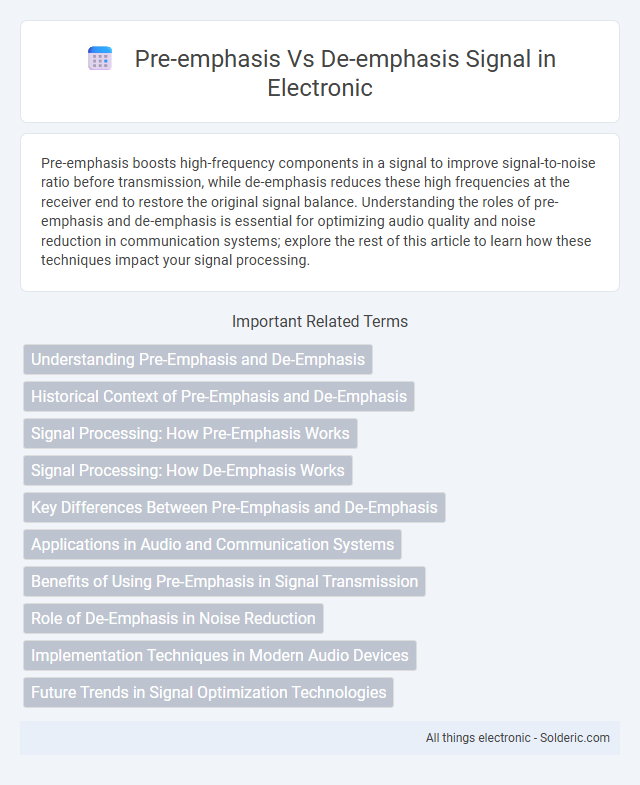Pre-emphasis boosts high-frequency components in a signal to improve signal-to-noise ratio before transmission, while de-emphasis reduces these high frequencies at the receiver end to restore the original signal balance. Understanding the roles of pre-emphasis and de-emphasis is essential for optimizing audio quality and noise reduction in communication systems; explore the rest of this article to learn how these techniques impact your signal processing.
Comparison Table
| Aspect | Pre-emphasis | De-emphasis |
|---|---|---|
| Purpose | Boosts high-frequency signals to improve signal-to-noise ratio during transmission. | Reduces high-frequency signals to restore original frequency response after transmission. |
| Application | Applied at the transmitter side before sending the signal. | Applied at the receiver side after receiving the signal. |
| Frequency Effect | Amplifies higher frequencies selectively. | Attenuates higher frequencies selectively. |
| Function | Compensates for noise and high-frequency roll-off. | Restores frequency balance and removes pre-emphasis effect. |
| Common Usage | FM broadcasting, audio recording, communication systems. | FM receivers, audio playback devices, communication receivers. |
Understanding Pre-Emphasis and De-Emphasis
Pre-emphasis and de-emphasis are signal processing techniques used to improve the signal-to-noise ratio in communication systems by altering frequency response. Pre-emphasis boosts the amplitude of higher frequency components before transmission, reducing the impact of noise during signal propagation. De-emphasis, applied at the receiver end, restores the original frequency balance by attenuating the boosted frequencies, ensuring Your audio or data signals maintain clarity and fidelity.
Historical Context of Pre-Emphasis and De-Emphasis
Pre-emphasis and de-emphasis techniques emerged during the early development of FM broadcasting to improve signal-to-noise ratio by amplifying higher audio frequencies before transmission and attenuating them upon reception. This approach addressed the inherent high-frequency noise characteristics in communication channels, enhancing audio clarity and overall listener experience. You benefit from this legacy through improved audio fidelity in modern analog and digital communication systems.
Signal Processing: How Pre-Emphasis Works
Pre-emphasis in signal processing boosts the amplitude of higher-frequency components before transmission, improving the signal-to-noise ratio and reducing distortion caused by channel characteristics. This frequency-dependent filtering emphasizes rapid signal changes, making the overall signal more resilient during transmission. De-emphasis reverses this effect at the receiver by attenuating the boosted high frequencies, restoring the original signal balance and minimizing noise amplification.
Signal Processing: How De-Emphasis Works
De-emphasis in signal processing reduces high-frequency noise that was boosted during pre-emphasis by applying a frequency-dependent attenuation, restoring the original signal balance. This process uses a de-emphasis filter that inversely shapes the frequency spectrum, counteracting the pre-emphasis curve applied at the transmitter or recording end. Your audio system benefits from improved signal-to-noise ratio and clearer sound by accurately implementing de-emphasis to complement pre-emphasis.
Key Differences Between Pre-Emphasis and De-Emphasis
Pre-emphasis amplifies high-frequency signals before transmission to improve signal-to-noise ratio and reduce the impact of noise and attenuation. De-emphasis, conversely, attenuates these amplified high frequencies after reception to restore the original signal balance. The key difference lies in their operational timing within the communication system, with pre-emphasis applied at the transmitter and de-emphasis at the receiver.
Applications in Audio and Communication Systems
Pre-emphasis enhances high-frequency components of audio or communication signals, improving signal-to-noise ratio and reducing distortion during transmission. De-emphasis attenuates these boosted frequencies at the receiver end, restoring the original signal balance and minimizing noise effects. Your audio or communication system relies on this pair to ensure clearer sound quality and more reliable data transmission.
Benefits of Using Pre-Emphasis in Signal Transmission
Pre-emphasis enhances high-frequency components of a signal before transmission, improving signal-to-noise ratio and reducing the impact of noise and interference during propagation. This technique minimizes signal degradation over long distances by compensating for the frequency-dependent losses inherent in transmission media. Using pre-emphasis results in clearer audio and data signals, especially in FM broadcasting and communication systems.
Role of De-Emphasis in Noise Reduction
De-emphasis plays a crucial role in noise reduction by attenuating high-frequency signals that were previously boosted during the pre-emphasis process, effectively restoring the original signal balance. This technique minimizes the impact of high-frequency noise introduced during transmission, improving the overall audio quality and clarity. By applying de-emphasis, your audio system ensures a cleaner output with reduced hiss and distortion, enhancing the listening experience.
Implementation Techniques in Modern Audio Devices
Pre-emphasis and de-emphasis are critical signal processing techniques implemented in modern audio devices to improve the signal-to-noise ratio and reduce high-frequency noise during transmission. Pre-emphasis boosts high-frequency components before transmission, while de-emphasis attenuates these frequencies to their original levels upon reception, commonly achieved through analog RC filters or digital signal processing algorithms. Your audio device leverages these techniques using efficient DSP units or integrated analog circuits to ensure clearer sound quality and reduced distortion in both wired and wireless audio systems.
Future Trends in Signal Optimization Technologies
Future trends in signal optimization technologies highlight advanced pre-emphasis and de-emphasis techniques that enhance signal clarity by effectively managing high-frequency noise and distortion. Emerging adaptive algorithms dynamically adjust these processes in real-time to optimize signal integrity across diverse communication channels. Your communication systems will benefit from these innovations through improved data transmission reliability and reduced error rates in increasingly complex signal environments.
pre-emphasis vs de-emphasis signal Infographic

 solderic.com
solderic.com